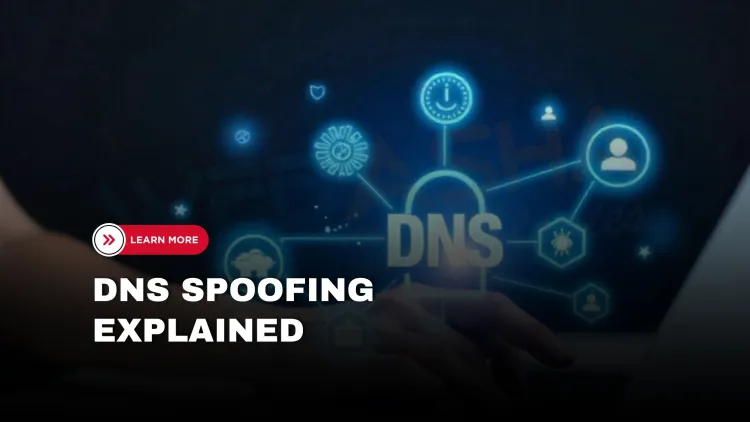What Is Internet DNS Spoofing? How It Works, Risks & Prevention (2025 Guide)
Learn what DNS spoofing is, how attackers redirect traffic using fake DNS responses, real-world examples, and how to prevent DNS cache poisoning in 2025. Protect your web traffic from hidden cyber threats.

Table of Contents
- What Is DNS and Why Is It Important?
- What Is DNS Spoofing?
- How Does DNS Spoofing Work?
- Real-World Example
- Why Is DNS Spoofing Dangerous?
- Common Targets of DNS Spoofing
- Tools Used in DNS Spoofing
- How to Detect DNS Spoofing
- How to Prevent DNS Spoofing
- Role of Security Teams and ISPs
- DNS Spoofing vs DNS Hijacking
- Conclusion
- Frequently Asked Questions (FAQs)
DNS Spoofing, also known as DNS cache poisoning, is one of the most deceptive and dangerous cyberattacks on the internet. It targets the very system that makes web browsing possible — the Domain Name System (DNS) — allowing attackers to redirect users to malicious websites without their knowledge.
Whether you're a cybersecurity student, an IT professional, or just an everyday user, understanding how DNS spoofing works is crucial for protecting data, systems, and personal privacy online.
What Is DNS and Why Is It Important?
The Domain Name System (DNS) is often called the “phonebook of the internet.” When you type a website like www.google.com, DNS translates it into an IP address (e.g., 142.250.190.14) so your browser can load the correct website.
If DNS gets compromised, you could be unknowingly directed to a fake version of a website—even if you typed the correct URL.
What Is DNS Spoofing?
DNS Spoofing is a technique where an attacker tricks a DNS resolver into caching and returning a fake IP address for a legitimate domain name. This misleads users and routes their web traffic to malicious servers controlled by the attacker.
These fake sites may:
-
Look like real banking or login pages
-
Steal credentials and sensitive data
-
Install malware on your device
This type of attack is particularly dangerous because users see no signs that they’ve landed on a fraudulent site.
How Does DNS Spoofing Work?
DNS spoofing typically happens in the following stages:
DNS Request
You enter a website URL. Your system sends a DNS request to a DNS resolver.
Attack Injection
The attacker, positioned between your computer and the DNS server, responds faster with a forged DNS response, mapping the domain to a malicious IP address.
DNS Cache Poisoning
The DNS resolver stores the fake IP in its cache. All future users relying on that resolver are now redirected to the wrong site.
User Redirect
You get directed to the attacker’s server, which can steal credentials, serve malware, or imitate legitimate web services.
Real-World Example
In 2020, users attempting to log into a cryptocurrency exchange were redirected to a spoofed version of the site through DNS cache poisoning. The attackers stole millions in Bitcoin before the exploit was patched.
Why Is DNS Spoofing Dangerous?
-
Hard to detect: The URL in the browser appears normal.
-
Scalable: One poisoned DNS cache can mislead thousands of users.
-
Data theft: Can steal logins, financial data, and other sensitive info.
-
Used in man-in-the-middle attacks: Enables attackers to eavesdrop or alter data.
Common Targets of DNS Spoofing
-
Online banking portals
-
Government websites
-
SaaS platforms and login pages
-
Social media sites
-
Public Wi-Fi users
-
ISPs with outdated DNS security
Tools Used in DNS Spoofing
Attackers use tools like:
-
Ettercap: For MITM attacks and DNS spoofing
-
dsniff: Packet sniffer that helps with DNS attacks
-
Bettercap: Advanced version of Ettercap for sniffing and spoofing
-
Cain & Abel: Legacy tool used for ARP poisoning and DNS redirection
How to Detect DNS Spoofing
-
Unexpected redirects even when entering the correct domain
-
SSL warnings (e.g., "certificate not valid")
-
Different IP address for a familiar website
-
Unusual DNS resolver entries in your network configuration
-
Use tools like
nslookup,dig, orWiresharkto trace DNS paths
How to Prevent DNS Spoofing
Use DNSSEC (Domain Name System Security Extensions)
DNSSEC uses cryptographic signatures to verify that DNS responses are authentic and haven’t been tampered with.
Use Encrypted DNS Protocols
-
DoH (DNS over HTTPS)
-
DoT (DNS over TLS)
These secure DNS queries using encryption to prevent MITM attacks.
Keep Systems Updated
Many DNS attacks exploit known vulnerabilities in outdated routers, systems, or applications.
Use Trusted DNS Resolvers
Use secure, public DNS providers like:
-
Google DNS (
8.8.8.8) -
Cloudflare (
1.1.1.1) -
Quad9 (
9.9.9.9)
Monitor DNS Traffic
Set up tools that monitor and analyze DNS traffic patterns for anomalies.
Role of Security Teams and ISPs
Security professionals must:
-
Implement DNSSEC on authoritative servers
-
Harden DNS resolver configurations
-
Block outbound traffic to unauthorized DNS servers
-
Monitor DNS logs for unusual behavior
DNS Spoofing vs DNS Hijacking
While similar, DNS Hijacking usually happens at the domain registrar level where the DNS records are altered. DNS Spoofing, on the other hand, manipulates traffic in transit or at the resolver level.
Conclusion
DNS spoofing attacks are silent but severe. They exploit one of the core systems of the internet, making it critical for users, developers, and organizations to understand the threat and adopt modern defenses.
Whether you're a student in cybersecurity or managing enterprise IT infrastructure, protecting DNS means protecting every digital interaction.
Stay vigilant, monitor DNS logs, and encrypt your queries.
FAQs :
What is DNS spoofing?
DNS spoofing is a cyberattack where fake DNS data is injected into a DNS resolver’s cache, redirecting users to malicious sites.
How does DNS spoofing work?
Attackers forge DNS responses, tricking a resolver into storing incorrect mappings between domain names and IP addresses.
What is DNS cache poisoning?
It’s when an attacker fills a DNS server’s cache with fake data, so users are sent to the wrong IP when accessing legitimate domains.
What is the difference between DNS spoofing and DNS hijacking?
DNS spoofing manipulates data in transit or cache, while DNS hijacking involves changing DNS records at the domain registrar level.
What are the risks of DNS spoofing?
Users may be redirected to fake websites where credentials, personal data, and financial information can be stolen.
Can DNS spoofing happen on public Wi-Fi?
Yes, attackers often use unsecured public Wi-Fi networks to perform DNS spoofing and man-in-the-middle attacks.
What tools do attackers use for DNS spoofing?
Popular tools include Ettercap, Bettercap, Cain & Abel, and dsniff.
What is DNSSEC?
DNSSEC (Domain Name System Security Extensions) adds digital signatures to DNS responses to ensure their authenticity.
How does DNSSEC help prevent spoofing?
It validates DNS responses using cryptographic keys, ensuring responses haven't been tampered with.
What is DoH?
DNS over HTTPS (DoH) encrypts DNS queries using HTTPS to protect them from interception.
What is DoT?
DNS over TLS (DoT) uses TLS encryption to secure DNS queries from tampering and eavesdropping.
Can DNS spoofing be detected?
Yes, using tools like Wireshark, dig, or nslookup, along with monitoring DNS logs for irregularities.
Is DNS spoofing still a threat in 2025?
Yes, especially with many legacy systems still lacking DNSSEC and encrypted DNS protocols.
What is a real-world example of DNS spoofing?
In past attacks, users of cryptocurrency exchanges were redirected to lookalike phishing sites through spoofed DNS responses.
What is a Man-in-the-Middle (MITM) DNS attack?
It’s when an attacker sits between the user and DNS resolver to intercept and modify DNS requests and responses.
How can users prevent DNS spoofing?
Use secure DNS providers, enable DNSSEC, update routers/software, and avoid using public Wi-Fi for sensitive tasks.
What DNS providers support DNSSEC and encrypted DNS?
Cloudflare (1.1.1.1), Google DNS (8.8.8.8), and Quad9 (9.9.9.9) support modern DNS protections.
How can companies secure their DNS infrastructure?
By enabling DNSSEC, monitoring logs, limiting zone transfers, and using internal DNS resolvers with tight controls.
What is DNS traffic monitoring?
It involves analyzing DNS request and response patterns to detect spoofing attempts or unusual behavior.
Can DNS spoofing be used in phishing attacks?
Yes, attackers use spoofed DNS entries to direct users to fake login or banking pages.
Is antivirus software enough to stop DNS spoofing?
Not always. DNS spoofing operates at the network level and often requires firewall or DNS-layer protection.
Should mobile users worry about DNS spoofing?
Yes, especially when using mobile data or public hotspots without VPN or encrypted DNS settings.
What is split DNS?
Split DNS is a technique where internal and external DNS queries are resolved differently for security and efficiency.
How often should DNS logs be reviewed?
Ideally daily in sensitive environments or at least weekly for general network health and spoofing detection.
Does VPN help prevent DNS spoofing?
Yes, many VPNs encrypt DNS traffic and prevent local network-based spoofing attacks.
What is a rogue DNS server?
It’s a malicious DNS server that provides incorrect DNS responses to redirect traffic.
Can firewalls help with DNS spoofing?
Yes, next-gen firewalls with DNS filtering and threat detection can block malicious DNS traffic.
What is DNS tunneling?
A technique that uses DNS queries to tunnel data and evade firewalls, often abused in advanced spoofing or exfiltration.
What does “usesCleartextTraffic=true” mean in Android apps?
It allows apps to send unencrypted data—including DNS—which could expose them to spoofing attacks.
How to secure IoT devices against DNS spoofing?
Update firmware, disable unnecessary services, and configure secure DNS resolvers with encryption.














![Top 10 Ethical Hackers in the World [2025]](https://www.webasha.com/blog/uploads/images/202408/image_100x75_66c2f983c207b.webp)








